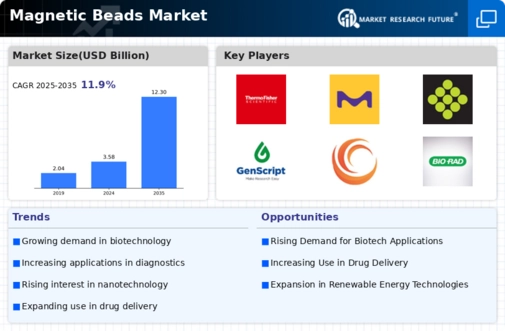Top Industry Leaders in the Magnetic Beads Market
 Magnetic beads, tiny workhorses of the biotech world, are revolutionizing research and diagnostics. These coated magnetic spheres, attached to specific molecules or biomolecules, act like tiny magnets, enabling separation, purification, and analysis of proteins, nucleic acids, and other biological targets with unparalleled efficiency and precision. Navigating the competitive landscape of this dynamic market is crucial for both established players and aspiring newcomers seeking to capitalize on the magnetic pull of this technology.
Magnetic beads, tiny workhorses of the biotech world, are revolutionizing research and diagnostics. These coated magnetic spheres, attached to specific molecules or biomolecules, act like tiny magnets, enabling separation, purification, and analysis of proteins, nucleic acids, and other biological targets with unparalleled efficiency and precision. Navigating the competitive landscape of this dynamic market is crucial for both established players and aspiring newcomers seeking to capitalize on the magnetic pull of this technology.
Strategic Maneuvers for Market Dominance:
Leading players like Thermo Fisher Scientific, Merck, Miltenyi Biotec, Bio-Rad, and Qiagen employ a range of strategies to stay ahead of the curve:
-
Product diversification: Offering a vast array of magnetic beads with diverse surface coatings tailored to specific applications and target molecules. This includes beads for protein purification, nucleic acid extraction, cell isolation, and even drug delivery. -
Technological innovation: Investing heavily in R&D to develop novel magnetic bead materials, coatings, and functionalities. This includes exploring smaller bead sizes for increased sensitivity, biocompatible coatings for improved cell viability, and multifunctional beads for streamlined workflows. -
Regional expansion: Targeting high-growth markets like Asia Pacific and Latin America by establishing local production facilities and adapting offerings to regional regulations and research priorities. -
Vertical integration: Gaining control over the supply chain by acquiring raw material suppliers or expanding into downstream applications like automated bead-based separation systems and custom assay development. -
Strategic partnerships: Collaborating with research institutions, universities, and technology startups to accelerate innovation, address technical challenges, and explore new application possibilities.
Factors Dictating Market Share:
Success in this magnetic market hinges on several key factors:
-
Bead performance: Delivering beads with high binding affinity for target molecules, efficient separation, and minimal background noise, ensuring accuracy and sensitivity in downstream assays. -
Scalability and automation: Offering beads suitable for high-throughput applications and compatible with automated laboratory instruments for efficient and cost-effective workflows. -
Cost competitiveness: Balancing high performance with affordability, especially in price-sensitive segments like clinical diagnostics and large-scale research projects. -
Regulatory compliance: Ensuring adherence to stringent regulations regarding biocompatibility, safety, and disposal of magnetic beads, particularly in medical and pharmaceutical applications. -
Technical expertise and customer service: Building strong relationships with clients through responsive technical support, customized solutions, and efficient after-sales support.
Key Companies in the Magnetic Beads market include
Thermo Fisher Scientific Inc.
Merck KGaA
Bangs Laboratories Inc.
Spherotech, Inc
GenScript
CardioGenics Inc.
Bio-Rad Laboratories, Inc.
Miltenyi Biotec
Ferrotec (USA) Corporation
Eurofins Technologies
Micromod Partikeltechnologie GmbH
New England Biolabs
Rockland Immunochemicals, Inc.
MagQu Co. Ltd
Recent Developments:
-
October 2023: Advancements in nanotechnology enable the development of ultra-small magnetic beads with enhanced sensitivity and binding capacity, opening up new avenues for molecular analysis. -
November 2023: The increasing focus on personalized medicine leads to the development of magnetic bead-based assays for targeted drug discovery and biomarker identification. -
December 2023: Concerns over environmental sustainability drive research into biodegradable and biocompatible magnetic beads for greener research practices.

